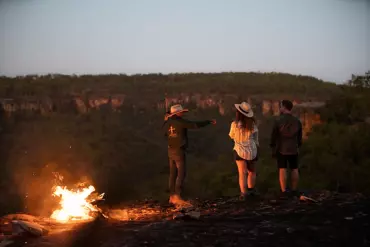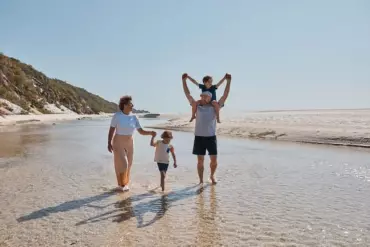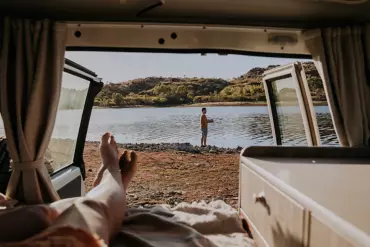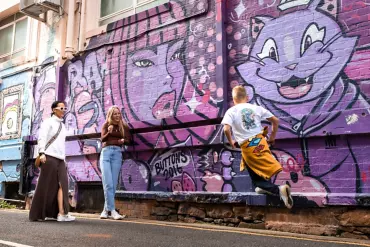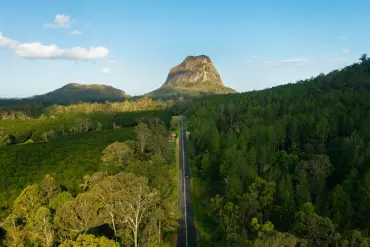Discovering Mission Beach and Tully in 48 hours
ITINERARY

By Sarah Bristow
Published 3 years ago
The irony that the wettest town in Queensland is just 200-odd kilometres from the sunniest is not lost on us.
North Queensland has always been an environment of contrasts - dry season and wet season, sugarcane and spinifex, rainforest and reef. So the contrast of sleepy, beachside towns like Tully and Mission Beach compared to their big-city counterparts, Townsville and Cairns, doesn’t surprise us at all.
The Cassowary Coast is a quiet stretch running from Cairns to Cardwell. Often overlooked in favour of more glamorous sections of the golden coastline, it’s perfect for anyone who wants to escape the well-worn tourist tracks.
Explore the other side of North Queensland’s townships along the Cassowary Coast. This guide will take you through exactly what to do in Mission Beach and Tully in just 48 hours.
Day 1
First up: Getting there

The drive between Townsville and Tully might only take 2.5 hours, but you’ll need to change shirts to cope with their meteorological differences.
Aside from this weather contrast, the 208km-drive between the two is punctuated with a stop at Queensland’s answer to Little Italy, Ingham. So known because of the mass influx of Italian immigrants who settled there, Ingham is where you’ll get a taste of authentic Italian in the middle of rural Queensland. Fuel up at JK’s Deli before getting back on the road to Tully.
There’s no point doing this drive in a rush because you’ll want to stop off at the idyllic Cardwell Blue Pools. To find this turquoise oasis, follow signs to the Cardwell Lookout to spot this spa pool at the end of a 5km unsealed road (still suitable for two-wheel-drive cars).
If you’re coming from Cairns, it’s just 1 hour and 50 minutes south to reach Tully.
Tour the sugar mill
Arrive in Tully, whose success story is penned by the sugar-cane and banana industry. In fact, sugar is this town’s primary industry, growing 22,000 hectares of the stuff.
Tour the sugar mill during processing season from June to November to watch the cane transform from stalks into raw sugar crystals. Hard hats and protective glasses essential.
Visit the giant gumboot

Tully has an average annual rainfall of 4.4m making it the wettest town in Australia, so they built a 7.9m high fiberglass gumboot to celebrate its status. It’s built to the scale of the annual rainfall in 1950, which should give you an idea of the kind of wet season Tully is up against.
The Golden Gumboot also doubles as a lookout. Climb to the top to drink in the views over the Tully Sugar Mill.
Head to Tully Gorge

Photo by @thegingerwanderlust
With such high rainfall, it’s no surprise Tully has access to some of the state’s most beautiful waterfalls. Chief among them, Tully Falls, a 300m waterfall, which drops impressively from the gorge to the river below. To get to Tully Falls is just 10km south of Ravenshoe, if you wanted to loop in a visit to the tablelands.
Otherwise, head to the gorge. Tully Gorge National Park is just a 30 minute drive from Tully. This park is one of the wettest areas in Australia, and part of the Wet Tropics World Heritage Area. The tropical vegetation supports tonnes of native species like the golden bowerbird and Lumholtz’s tree-kangaroo, both of which can only be found in the Wet Tropics.

As you would expect, the parkland is awash with waterfalls, streams, creeks, and king among them is the turbulent Tully River. The river generates so much water you can actually white-water raft down level 3 and 4 rapids all year round.
If that’s playing it too safe for your adrenal glands, book in for Raging Thunder’s Xtreme Rafting experience. This will see you swimming in the rapids and riding over boulders to reach the most idyllic waterfall spots. Is there any better way to see the rainforest?
Overnight: Tully Motel
The atmosphere created at Tully Motel is absolute comfort. Conveniently located just off the Bruce Highway, this is the perfect pitstop for travellers in need of some creature comforts and a serene break. Call it a day and grab dinner at the motel’s on site restaurant, Plantations. Tully Motel is also completely pet friendly if you’re travelling with four-legged family.
Day 2
Venture to Mission Beach

Wake up with a full continental breakfast delivered to your room, then it’s back in the wagon to Mission Beach, just 30kms north.
If you’re not already familiar with Mission Beach, expect a sleepy beach-side resort town. Unlike other townships along the Queensland coastline, this one isn’t framed by rainforest on one side and reef on the other. Expect no adrenalin junkies or complicated luxe. Mission Beach is a quiet place where folks come to relax into the natural splendour of the Wet Tropics.
Explore four villages by bike

Rather than having one main hub, Mission Beach is made up of a constellation of four villages: South Mission Beach, Wongaling Beach, North Mission Beach and Bingil Bay.
Connecting these four small townships is 14km of palm-fringed beach and boardwalk, and the terrain is perfectly flat so it’s perfect for a self-guided cycling tour.
Go see the guys that run Mission Beach Water Taxi and pick up a bike for just $20 a day. The choice is yours between a casual cruiser for rolling along the boardwalk, or a sturdier mountain bike for taking on the national parkland. If you’re going for the former, make sure you duck into the Helen Willshire Gallery to check out some bright local canvases.
Prefer to explore on foot? Start with a leisurely stroll along the Cutten Brothers Walking Track, or explore the Wet Tropics National Park with the Lacey Creek Circuit. If you fancy more of a challenge, take on the Bicton Hill Circuit Track, which takes you to the summit of Clump Mountain National Park and back in about two hours.
Get dunked

Photo by @australia
Just four kilometres off the coast of Mission Beach is the Family Group of Islands. The major islands in the cluster are identified by the local Indigenous community by their role in the family.
Start your exploration with the ‘father’ island, Coonanglebah. Also known as Dunk Island, this rainforest island is a prime spot for secluded island adventures. Explore the surrounding waters and reef with Coral Sea Kayaking, or trek to the highest point of the island on Mount Kootaloo.
If you wanted to stay the night you’re more than welcome. Although the island took a beating in the wake of Cyclone Yasi, the father island still offers camping ground for all those who want to pitch a tent and sleep to the sounds of the rainforest.
Overnight: Mission Beach Hideaway Holiday Village
It doesn’t get much closer to the beach than Mission Beach Hideaway. In fact, you’ll want to keep some sand pegs handy if you choose to camp. Of course there are also ensuite villas and cabins for anyone craving creature comforts.
Day 3
Go cassowary spotting

It isn’t called the Cassowary Coast for nothing. Being an endangered species, the cassowary is one of the rarest sights in Far North Queensland. Keep your eyes peeled for their glossy black plumage, bright blue neck and red wattles as they forage around sunrise and sunset.
Since there are only 4000 left in the wild, you’ll want to read up to shortcut your efforts to see these prehistoric birds.
Continue north

As the crow flies it’s only 140km north from Mission Beach to the tropic's capital, Cairns. That is, if you don’t get distracted by these waterfalls, secret lakes or places to graze on the Atherton Tablelands, which are worthy of their own bucket-list itinerary.
Of course, if you felt like sticking around, there’s plenty to stretch your time in Mission Beach into a three day stay.
If you’re driving the other way, here’s everything you need to know about the drive between Mission Beach and Cairns.
You may also like

Ready to ROAM?
Join our Queensland crew and get destination inspiration, insider tips, exclusive deals sent straight to your inbox. Let the exploring begin!
Sign up now